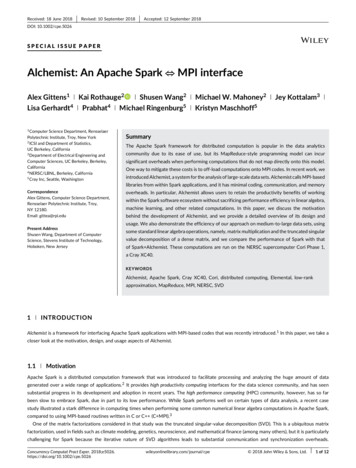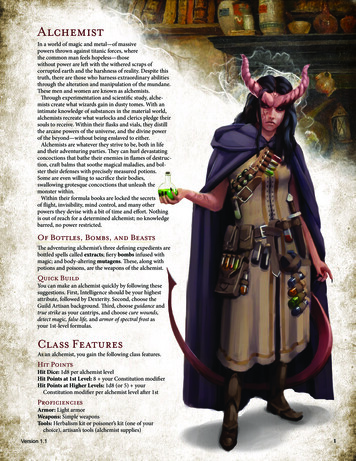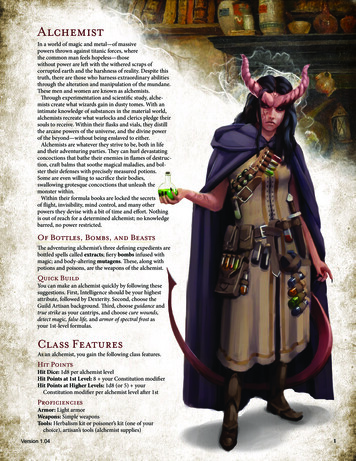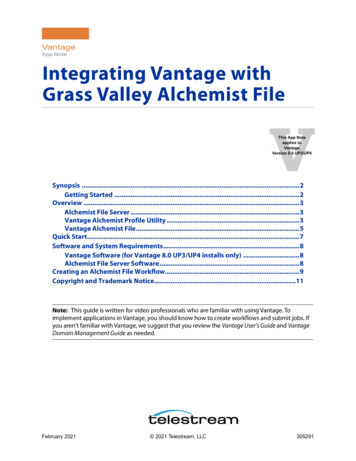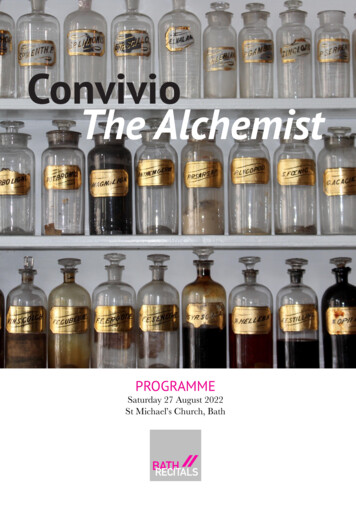
Transcription
ConvivioThe AlchemistPROGRAMMESaturday 27 August 2022St Michael’s Church, Bath
We need you more than everWe have been looking forward to the return ofConvivio since their wonderful concert herewith Bath Recitals last year - and here theyare with this fantastic programme of Baroque delights byHandel and his Contemporaries.There are two more concerts to look forward tolater this year with one of the U.K.’s most exciting youngpiano trios, New Generation Artists, Mithras Trio. This willbe followed by a suitably seasonal finale with Concertos forChristmas and the Dionysus Ensemble.We always love to acknowledge our Bath RecitalsFriends without whom none of this would be possible. Butthere are challenging times and more than ever we need toencourage more of you to join our Friends scheme.It really does make a difference - not just theadditional funds this brings in (it’s only 57p a week!) - butalso to show that we have grassroots support for what wedo. This enables us to lever in much needed financialsupport from bigger funders.You can join online at our website:bathrecitals.comHave a wonderful evening!The Bath Recitals teamDON’T MISS THESE OTHER GREAT EVENTS IN 2022Mithras TrioConcertos for ChristmasSaturday 15 October, 7.30pmSt Michael’s Church, BathSaturday 17 December, 7.30pmSt Michael’s Church, BathTickets for all events are on sale at www.bathrecitals.comBath Recitals, 42 Great Pulteney Street, Bath BA2 4DRwww.bathrecitals.com Registered Charity Number 1051410Programme designed by Revolution Arts, www.revolutionarts.co.uk2
Bath Recitals 2022 SeasonConvivio: The AlchemistProgrammeG. F. Handel (1685-1759)The Alchemist SuiteJohann Friedrich Fasch (1688-1758)Sonata in F majorJohann Adolf Hasse (1699-1783)Oboe Concerto in F majorINTERVALG. F. Handel (1685-1759)Sinfonia in B-flatAntonio Vivaldi (1678 - 1741)Sinfonia in GG.P. Telemann (1681-1767)Concerto for 2 oboes, bassoon and strings in D minor3
G. F. Handel(1685-1759)The Alchemist SuiteThe Suite takes the form of an ‘overture-suite’,with an overture in the French style (consisting of a statelyopening leading into a fugue) followed by a selection ofdances.Although these dances had various origins – the jig,for example, came from Britain and Ireland – they achievedtheir form in the mature baroque dance suite mainlythrough the prism of the style that developed at the Frenchcourt.Thus the sarabande, originally a fast Spanishdance that was widely viewed as dangerously immoral andbanned in 1583, evolved into a slow dance of greatexpressive potential.I. Overture (Allegro)II. MinuetIII. SarabandIV. BoréeV.AireVI. MinuetVII. AireVIII. JiggTonight’s concert opens with perhaps the first pieceby Handel to have been performed in England, asuite of incidental music used in a 1710 Londonrevival of Ben Jonson’s comedy The Alchemist.The music was published as the work of ‘an ItalianMaster’, but London audiences would soon be familiar withthe name of the composer, who moved permanently to theircity in 1712.Handel did not compose the music specifically forThe Alchemist; most of it comes from his opera Rodrigo(1707) and was arranged by an unknown composer, whoalso seems to have added the brisk second movement.4
Johann Friedrich Fasch(1688-1758)Sonata in F majorI. LargoII. AllegroIII. LargoIV. AllegroIn 1722, Fasch was invited to apply for the positionof cantor at his alma mater, the St Thomas School inLeipzig, but withdrew his name from consideration; the postwent to Bach.Fasch’s Sonata in F follows another popular formatfor baroque instrumental works, that of the sonatada chiesa (‘church sonata’), consisting of a slow-fastslow-fast sequence of movements.Although instrumental music such as sonatas wereincreasingly inserted into liturgical ceremonies in theseventeenth century, the title sonata da chiesa came to beapplied to pieces composed for secular use to distinguishthem from the sonata da camera, which was made up ofdances.This example of the former by Johann FriedrichFasch is notable for providing the bassoon, which normallyplays the bass line with the basso continuo, with anindependent and virtuosic individual part.Fasch is a composer whose present obscuritycontrasts with the wide esteem in which he was held in hisown time, including by Telemann and Bach, both of whomperformed his works.5
Johann Adolf Hasse(1699-1783)Oboe Concerto in F majorI. AllegroII. AdagioIII. AllegroThe final piece in the first half is by anothercomposer who, despite being known only tobaroque connoisseurs today, was immenselypopular in his day.Born near Hamburg in 1699, Johann AdolphHasse spent many years in Naples and became well knownfor his dozens of operas.The piece performed today is in a genreconsidered typical of the Italian style and perhaps bestexemplified by the music of Vivaldi – a three movementconcerto demonstrating the virtuosity of a solo instrument,in this case the oboe.Its style is arguably lighter and more galant thansome of the other works in the programme, reflecting thefact that Hasse was younger and lived into the 1780s.6
G. F. Handel(1685-1759)Sinfonia in B-flatI. PomposoII. Air lentementIII. A tempo ordinarioThe second half of the concert includes two worksentitled ‘sinfonia’. Before the symphony as weknow it had started to take shape in the classicalperiod, the word was used most normally to refer toinstrumental introductions or interludes in operas, oratorios,and cantatas.As so often with Handel – a master recycler or‘borrower’ of his own and other composers’ music – thesame pieces frequently appear in different works, sometimesdecades apart. The ‘air lentement’ in this sinfonia was alsoused at the beginning of the oratorio Joshua (1747) andanother version of the two outer movements can be foundin the Organ Concerto Op. 7, No. 6.7
Antonio Vivaldi(1678 - 1741)Sinfonia in GI. AllegroII. Andante e sempre pianoIII. PrestoSinfonia was a label attached to instrumental piecesrather than a settled form, and the string example byVivaldi is rather different to the Handel work.In many respects, it is similar in style to Vivaldi’sfamously enormous corpus of concertos, many of whichwere written for the all-female ensemble of the Ospedaledella Pietà, the Venetian orphanage where he was employedas violin master.The difference is that in this sinfonia the violinsplay in unison or thirds, rather than having one soloist setagainst the rest of the orchestra.In addition to the solo concerto, the concertogrosso was a popular form in the baroque period. In thisgenre, a small group of soloists (the concertino) is set againstthe larger orchestra (ripieno).In the concerti grossi of Corelli and Handel, theconcertino is made up of a trio of string players; Bach’sBrandenburg Concertos, on the other hand, employ highlyunusual combinations of solo instruments.8
G.P. Telemann(1681-1767)Concerto for 2 oboes,bassoon and strings in D minorI. GraveII. AllegroIII. AffettuosoIII. VivaceThe final work in the programme is a Telemannconcerto in which a wind trio of two oboes andbassoon form the corpus of soloists.An enormously prolific composer who was largelyself-taught as a musician, Telemann was immenselyrespected in his day and a friend of both Bach and Handel;knowing that Telemann was a botanical enthusiast, thelatter sent him crates of exotic English plants in the 1750s.Throughout his life, Telemann composed vastnumbers of instrumental sonatas, overture-suites, andconcertos.This particularly fine example is found in amanuscript from 1740 and forms a fitting ending to aprogramme reflecting the variety and vitality of baroqueinstrumental music.9
ConvivioChloe Prendergast ViolinSophie Simpson ViolinCShloe is a violinist currently based in theNetherlands. She is a member of HollandBaroque, as well as a founding member of theButter Quartet, a period-instrument string quartet dedicatedto the world of 18th- and early 19th-century performancepractice. She is co-creator of the podcast Outside theMusicBox as well as its associated concert series, both ofwhich break down barriers surrounding conventionalclassical music concerts in order to reach new classicalmusic-lovers.Chloe has performed across North America, theUK, and Europe with groups including English BaroqueSoloists, the Handel and Haydn Society, Seattle’s PacificMusicworks, Vox Luminis, the Henry Purcell Society ofBoston, the Wrocław Baroque Orchestra, Luthers BachEnsemble, and Le Concert d'Apollon.She has also appeared at music festivalsinternationally, including the Utrecht Early Music Festival,the Connecticut Early Music Festival, the BeethovenAcademy at the National Forum for Music in Poland,Wonderfeel, and Leipzig Bachfes.Chloe completed her master’s degree at the RoyalConservatory of the Hague with Kati Debretzeni andWalter Reiter and her bachelor’s degree at WillametteUniversity, where she was a Phil Hanni scholar and studiedprincipally with Anthea Kreston and Daniel Rouslin.10ophie studied Music at the University of York,followed by a Masters in Violin Performance at theRoyal Northern College of Music. Since graduatingin 2016 she has been busy pursuing a portfolio career inteaching and as a freelance performer on both modern andbaroque violin. Ensembles she performs with includeEnglish Baroque Soloists, London Handel Orchestra,London Handel Players, Orchestra of the Age ofEnlightenment, Instruments of Time and Truth,Manchester Camerata, Northern Ballet Sinfonia, OrpheusSinfonia, Southbank Sinfonia, Sinfonia Cymru, theEuropean Union Chamber Orchestra and BournemouthSymphony Orchestra.Sophie is also passionate about teaching andoutreach work; she has held teaching positions withinstitutions including the Royal College of Music JuniorDepartment, Chetham’s School of Music, Royal NorthernCollege of Music Young Strings, In Harmony Liverpool,Downe House, Cheam School and Music Masters.When she is not playing the violin, Sophie enjoyslearning French, playing netball and baking.
Hannah Gardiner ViolaHannah is a baroque and modern violist based inLondon. She read for her undergraduate degreein English Literature at King's College,Cambridge, and her masters at the Royal Academy ofMusic, where she studied with Jon Thorne, Martin Outram,and Annette Isserlis.She splits her time as a performer between Baroqueviola, on which she has played with groups including theEnglish Baroque Soloists, Orchestra of the Age ofEnlightenment, and La Nuova Musica, and the modernviola, primarily as a Chamber Musician.Highlights include being selected as a Park LaneGroup young artist for 2020 and winning the 2019 StMartin-in-the-Fields competition (both with the BromptonQuartet) and the inaugural Roscommon Chamber Festival.She is also committed to commissioning and premieringcontemporary music for viola, and is currently collaboratingwith several young composers.Jacob Garside CelloJacob is a freelance cellist and viola da gamba playerbased in London. He regularly plays for La NuovaMusica, OAE, St James Baroque, City BachCollective, Oxford Bach Soloists, among others.As a gamba player he has also played with RoyalNorthern Sinfonia (St John Passion), the viol consort NeweVialles and with Fretwork; recording two CDs with the latter.He also recorded a disk of Handel with La NuovaMusica in winter 2020,including the viol solo from Handel’sJulius Caesar with Lucy Crowe in the role of Cleopatra.Jacob attended the RAM studying baroque celloand viol with Jonathan Manson, and the RCM studying violwith Richard Boothby and Reiko Ichise. Supported by theEnlightenment and Hill Scholarships respectively.Outside of the concert hall he plays regularly forDuckie of The Royal Vauxhall Tavern, in their QueerHistory Club - Princess: The Queer Georgians, A BentHistory Bachannal.Joel Raymond OboeJoel was inspired by the sound of period instruments atan early age having attended his first periodinstrument concert at the Wigmore Hall aged 7.After Studing modern and period oboes atBirmingham Conservatoire he received a scholarship tostudy historical performance at the Royal Academy ofMusic graduating with their highest award for performancein 2004, and was made an Associate in 2011.Joel has performed world-wide in over 20 countrieswith amongst others The European Union BaroqueOrchestra, The Hanover Band, The Australian ChamberOrchestra, The Academy of Ancient Music, Ex Cathedra,The Orchestra of the Age of Enlightenment, The GabrielliConcort, The Brook Street Band, Norwich Baroque andManchester Baroque.Joel received a 2014 Fellowship from the WinstonChurchill Memorial Trust to study original 18th centuryoboes, visiting museums in 6 countries. He designs, buildsoboes, and continues to research 18th century instrumentsand their music.In 2018 he qualified as a Cognitive BehaviouralHypnotherapist, integrating CBT, hypnosis and mindfulnessJoel is particularly interested in helping people with anxietyand panic disorders.11
Hannah Blumsohn OboeHannah grew up in Sheffield and went on to studyoboe at the Guildhall School of Music andDrama, where she graduated with a 1st classdegree and subsequently was a Junior Fellow in HistoricalPerformance. She plays Baroque and modern oboe with adiverse range of ensembles around the UK, including theOrchestra of the Age of Enlightenment, English TouringOpera, London Baroque Orchestra, St James' Baroque(including at Westminster Abbey), Bellot Ensemble and theLondon Film Music Orchestra. Hannah loves teaching oboeand also teaches primary and early-years musicianship forNorth London Conservatoire. She has worked as a mentorfor the National Children's' Orchestra and has runworkshops for the British Double Reed Society.guest principal with orchestras such as LondonPhilharmonic Orchestra, BBC Philharmonic Orchestra andRTÉ Symphony Orchestra.As a soloist Catriona is a former Countess ofMunster and Handel House Talent artist. Catriona is also apassionate chamber musician, playing at festivals and venuesnationwide such as Wigmore Hall, Bridgewater Hall andRyedale Festival. As a baroque bassoonist she performs withEnsemble Molière, current BBC New Generation BaroqueEnsemble and as a modern player she is a member of windquintet Magnard Ensemble.Strongly believing in the importance of educationand community work, Catriona regularly works on and leadsa whole variety of projects, most recently leading MagnardEnsemble’s online early years show “Odd Dog Out”.Catriona is also an avid arranger/ composer and has severalpieces published with both Wonderful Winds and AlryPublications.Sean Heath HarpsichordCatriona McDermid BassoonSCatriona leads a varied career as a modern andperiod instrument bassoonist, keen educator andarranger. She received first-class honours for bothher undergraduate degree at Oxford and Masters degree atRoyal College of Music, where she studied with JoostBosdijk, Julie Price, Andrea de Flamineis and WouterWerschuren.Catriona is in demand as an orchestral bassoonist,performing with leading period instrument ensembles suchas Orchestra of the Age of Enlightenment, Academy ofAncient Music and English Baroque Soloists, and playingean studied at the Royal Academy of Music andCambridge. He is a Fellow of the Royal College ofOrganists and for several years was keyboardaccompanist at the University of St Andrews.His playing on Annunciations, a recording ofcontemporary music by the university choir, was describedas 'an immediate stand-out' by Choir and Organ.In recent months, Sean has played as continuoharpsichordist for a staged production of Monteverdi'sIncoronazione di Poppea in Saluzzo, Italy, and forperformances with Opera dei Lumi at the Edinburgh Fringe.Upcoming performances in the area include a recital on the1887 Hill organ of All Saint's, Cheltenham, on 8 October.Prior to the Covid pandemic, Sean also spentprolonged periods living in China where he gave masterclasslectures on figured bass in Mandarin at the CentralConservatory of Music, performed at the Forbidden CityConcert Hall and played for weekly mass in Mandarin andother languages at the city's several historic Catholicchurches.
Convivio: The Alchemist Programme G. F. Handel (1685-1759) The Alchemist Suite Johann Friedrich Fasch (1688-1758) Sonata in F major Johann Adolf Hasse (1699-1783) Oboe Concerto in F major INTERVAL G. F. Handel (1685-1759) Sinfonia in B-flat Antonio Vivaldi (1678 - 1741) Sinfonia in G G.P. Telemann (1681-1767)



